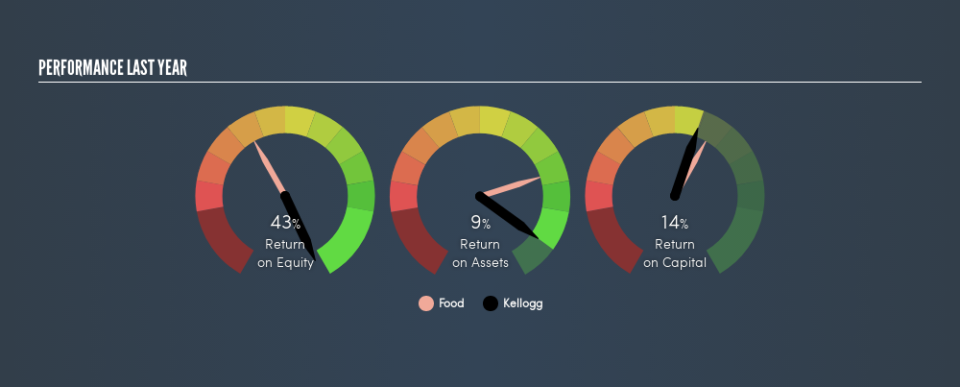Here's What Kellogg Company's (NYSE:K) ROCE Can Tell Us

Today we'll look at Kellogg Company (NYSE:K) and reflect on its potential as an investment. To be precise, we'll consider its Return On Capital Employed (ROCE), as that will inform our view of the quality of the business.
First, we'll go over how we calculate ROCE. Second, we'll look at its ROCE compared to similar companies. And finally, we'll look at how its current liabilities are impacting its ROCE.
Return On Capital Employed (ROCE): What is it?
ROCE measures the 'return' (pre-tax profit) a company generates from capital employed in its business. Generally speaking a higher ROCE is better. In brief, it is a useful tool, but it is not without drawbacks. Author Edwin Whiting says to be careful when comparing the ROCE of different businesses, since 'No two businesses are exactly alike.'
How Do You Calculate Return On Capital Employed?
The formula for calculating the return on capital employed is:
Return on Capital Employed = Earnings Before Interest and Tax (EBIT) ÷ (Total Assets - Current Liabilities)
Or for Kellogg:
0.14 = US$1.9b ÷ (US$18b - US$4.5b) (Based on the trailing twelve months to December 2018.)
Therefore, Kellogg has an ROCE of 14%.
See our latest analysis for Kellogg
Is Kellogg's ROCE Good?
ROCE is commonly used for comparing the performance of similar businesses. Kellogg's ROCE appears to be substantially greater than the 8.8% average in the Food industry. I think that's good to see, since it implies the company is better than other companies at making the most of its capital. Regardless of where Kellogg sits next to its industry, its ROCE in absolute terms appears satisfactory, and this company could be worth a closer look.
Remember that this metric is backwards looking - it shows what has happened in the past, and does not accurately predict the future. Companies in cyclical industries can be difficult to understand using ROCE, as returns typically look high during boom times, and low during busts. This is because ROCE only looks at one year, instead of considering returns across a whole cycle. Future performance is what matters, and you can see analyst predictions in our free report on analyst forecasts for the company.
How Kellogg's Current Liabilities Impact Its ROCE
Current liabilities include invoices, such as supplier payments, short-term debt, or a tax bill, that need to be paid within 12 months. The ROCE equation subtracts current liabilities from capital employed, so a company with a lot of current liabilities appears to have less capital employed, and a higher ROCE than otherwise. To counteract this, we check if a company has high current liabilities, relative to its total assets.
Kellogg has total assets of US$18b and current liabilities of US$4.5b. Therefore its current liabilities are equivalent to approximately 25% of its total assets. Current liabilities are minimal, limiting the impact on ROCE.
Our Take On Kellogg's ROCE
With that in mind, Kellogg's ROCE appears pretty good. There might be better investments than Kellogg out there, but you will have to work hard to find them . These promising businesses with rapidly growing earnings might be right up your alley.
If you are like me, then you will not want to miss this free list of growing companies that insiders are buying.
We aim to bring you long-term focused research analysis driven by fundamental data. Note that our analysis may not factor in the latest price-sensitive company announcements or qualitative material.
If you spot an error that warrants correction, please contact the editor at editorial-team@simplywallst.com. This article by Simply Wall St is general in nature. It does not constitute a recommendation to buy or sell any stock, and does not take account of your objectives, or your financial situation. Simply Wall St has no position in the stocks mentioned. Thank you for reading.


